Recounting the Rabhi-Fried Recount
Last Thursday, a hand recount of ballots was conducted in the District 11 Democratic primary election for Washtenaw County commissioner. Initial results from the Aug 3. election had yielded Yousef Rabhi as the winner in a field of four candidates – by one vote. The candidate with 997 votes counted on election day, compared to Rabhi’s 998, was Mike Fried, who asked that the ballots be recounted.
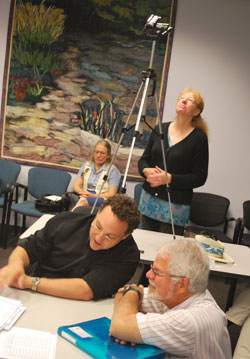
Before the Aug. 26 recounting got started, Conan Smith (left), a current county commissioner acting as one of Youself Rabhi's official "watchers," chats with Mike Fried (right), who'd asked for the recount. Shooting video for the Michigan Election Reform Alliance was Jan BenDor. Seated in the background is Alice Ralph, who came third in the balloting for the District 11 seat.
The process started around 12:30 p.m., and about four hours later in the lower level conference room of the county building at 200 N. Main St., the final ballots had been recounted – the last ones coming from Precinct 2 in Ann Arbor Township. [District 11 covers parts of southeast Ann Arbor and one precinct in Ann Arbor Township.]
Fried summed up the afternoon, conceding to Rabhi – who was still the winner after the recounting, with a relatively comfortable margin of two votes: “Well, congratulations!”
Fried continued with compliments all around for the board of canvassers and the election inspectors who handled the recounting, saying he was amazed that they had finished in four hours.
The board of canvassers consists of Tony DeMott (R), Melodie Gable (R), Ulla Roth (D), and Carol Kuhnke (D). The news was first reported by The Ann Arbor Chronicle live from the scene: “Rabhi Prevails on Recount.”
The work might have been completed sooner, had it not been for a snafu with the Ann Arbor Township ballot box. Initially, the box for Precinct 1, not Precinct 2, had been delivered for recounting. Getting access to the correct box depended on tracking down someone with a key to the room in the township clerk’s office, where the ballots are stored.
Recounted totals for the four candidates: Yousef Rabhi, 999; Mike Fried, 997; Alice Ralph, 280; LuAnne Bullington, 108.
The afternoon included a range of scenarios that illuminated some of the more arcane aspects of the voting system. Also in attendance was Joe Baublis, who will be on the ballot for the Republicans in November for the District 11 county board seat. He posed a question at the start of the proceedings: How much will this recount cost taxpayers?
How Much Does a Recount Cost?
In response to the question from Baublis, Washtenaw County deputy clerk Matt Yankee, who is acting director of elections, noted that the election inspectors at each of four tables are paid by the hour, and that the documents related to payment are subject to the Freedom of Information Act – in the event that anyone was curious to get an exact figure after the payments were made.
There were four tables with two election inspectors apiece, paid at an hourly rate of $15. For a roughly four-hour afternoon, that would amount to a ballpark estimate of (4 tables) x (2 people) x 15 (dollars/hr) x 4 (hours) = $480. In fact, the cost was dramatically less than that.
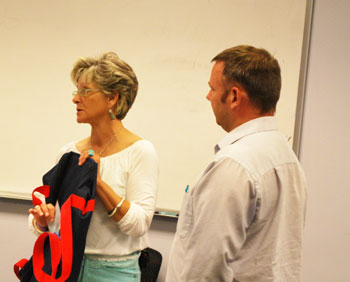
Melodie Gable and Tony DeMott, members of the board of canvassers, walk election inspectors through part of the unsealing procedure for the ballot duffel bags.
The Chronicle followed up with Yankee, who responded by email to a query for a better-than-ballpark estimate. The main reason that it cost less was that of the eight people who served as election inspectors, five didn’t need to be paid extra: one was a full-time permanent employee with the county clerk’s office; two were already part-time temp employees with the county clerk’s office; and two were employees from local jurisdictions.
That left three people people who needed to be hired specifically to work the day of the recount. Two of them worked 3.5 hours ($52.50) and the third worked 4.5 hours ($67.50). Yankee also noted that parking validation would be paid for those workers. [Based on hourly rates at structures of $0.45 per half hour, around $15 would cover parking for those three workers.]
Yankee noted that the $160 deposit posted by Fried ($10 per precinct for the 16 precincts involved in the recount) wouldn’t be refunded, because the outcome of the election did not change.
Based on board of canvasser Melodie Gable’s remarks in response to Baublis’ initial query, the four board members present were also paid $25 per day for their work.
An estimate of the final accounting for the day’s expenses:
EXPENSES $ 52.50 Election Inspector 52.50 Election Inspector 67.50 Election Inspector 25.00 Board of Canvassers 25.00 Board of Canvassers 25.00 Board of Canvassers 25.00 Board of Canvassers 15.00 Parking Validation $287.50 Total REVENUE $160.00 Deposit
-
The Missing Box: Ann Arbor Township Precinct 2
It was a slightly longer day than expected, due to the delivery of the box for Ann Arbor Township Precinct 1 ballots instead of the box for Precinct 2.
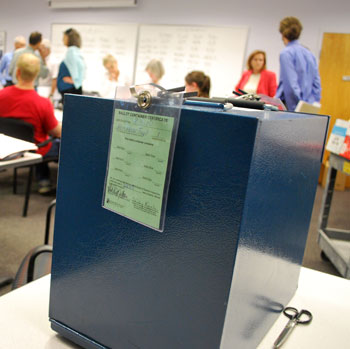
Ann Arbor Township's ballot box for Precinct 1 showing the side with the temporary seal. The other side of the box also has an opening, with a permanent seal.
The mistake can be traced to the physical configuration of the metal boxes used to store the ballots. This style of box has a point of entry on each side of the box – one of which is required by the state of Michigan to have a “permanent” seal. The other side is the seal containing the information specific to a particular election, including the precinct number.
The permanent seal for the box indicated Box 2, which apparently was misunderstood to mean that it contained the ballots for Precinct 2. In fact, Box 2 contained Precinct 1′s ballots.
When the mistake was recognized, the call out to Ann Arbor Township indicated that locating the key to the room where ballots are secured might pose a challenge.
A combination of August vacations plus absences due to personal reasons had raised a brief specter of a door getting broken down by the fire department or sheriff’s deputies. When a key was successfully located, the resolution to the “crisis” proved to be far less dramatic.
The city of Ann Arbor uses sturdy duffel bags, not the older style boxes.
Does It Match? Ann Arbor City Ward 3, Precinct 3
Ann Arbor city Ward 3, Precinct 3′s ballots offered a chance to work through some of the more arcane aspects of validation and cross-checking involved in election recounts.
Ward 3, Precinct 3: Seal Matches Poll Book?
Before any ballot containers are opened, the first step is to confirm that the poll book number assigned to the container matches the number indicated on the container seal. In the case of the Ward 3, Precinct 3 duffel bag, the numerical sequence indicated in the poll book matched the sequence on the duffel seal – except that there was an extra number 5 tacked on the end in the poll book, compared to the sequence on the duffel.
Lyn Badalamenti was one of the election inspectors working the table who discovered the mismatch. Her name might strike some Chronicle readers as familiar, because she was the Ann Arbor city clerk staffer who supplied Steve Bean with his paper work, when Bean took out his petitions to file as an independent candidate for mayor of Ann Arbor.
Badalamenti observed that the extra 5 yielded an 8-digit number, but that the city of Ann Arbor has no 8-digit seals. That is, the number indicated in the poll book denoted an non-existent seal. Members of the board of canvassers were called over to rule and voted unanimously in favor of accepting the explanation that a 5 had inadvertently been added. Said Tony DeMott, “I prefer to see ballots counted.”
Ward 3, Precinct 3: Number of Ballots Matches Poll Book Total?
After opening a ballot container, and before the actual recounting of ballots begins, the total number of ballots in the container is counted and compared to the number of ballots recorded on the tape produced by the optical scanning voting machine and recorded in the poll book. If the numbers don’t match, the ballots don’t get recounted.
For Ward 3, Precinct 3, the total number of ballots in the container was counted twice as 831 – but the poll book indicated 830 ballots. One ballot was identified as possibly the “extra” ballot. It had the telltale folds indicating it had been sent through the mail – an absentee ballot. It had “Flawed #5″ handwritten on it – indicating a ballot that should have been run through the optical scanning machine with a manual override, but apparently was not.
A brief discussion unfolded at the table around the idea that the ballot should have been placed by poll workers on election day in one of two envelopes marked either “original” or “spoiled.” The two envelopes correspond to two kinds of scenarios. The first is when poll workers need to make a duplicate of a ballot in order to get the machine to accept the vote. This is associated with absentee ballots, which are typically processed on election day during the course of the day. Poll workers feed the absentee ballots into the machine on behalf of voters.
But suppose an absentee ballot is physically defective in some way. One example Melodie Gable gave was that sometimes absentee voters will put a really hard crease into the ballot when they place it into the envelope, which causes problems with the optical scanning. The solution to getting the machine to read and count that voter’s selections is to duplicate exactly on a “clean” ballot all voting choices and to feed that ballot into the machine, saving the original ballot for the “original” envelope.
A different scenario involves an in-person voter who tries to submit a ballot that the machine does not accept due, for example, to cross-voting – that is, voting in both the Republican and Democratic primaries on the same ballot. In that case, the voter can be provided with a new ballot, advised again not to vote in both primaries, and given another shot at voting. Their original ballot, however, is preserved in the “spoiled” envelope. The Chronicle stumbled across this kind of situation during primary election day coverage:
1 p.m. Ward 5, Precinct 3: Second Baptist Church (850 Red Oak Drive).
[...]
Poll workers are handling a spoiled ballot from someone who apparently accidentally filled in votes for both primaries. The voter must fold it in half and place it in a special envelope, then re-try with a new ballot. Voting is a success.
When an absentee ballot is fed into the optical scanning machine and it’s rejected due to a physical defect in the paper, a duplicate can be made on behalf of the voter. But if the rejection is due to cross-voting, then poll workers are supposed to force the optical scanner to accept the ballot through an override, which the machine then counts as a ballot, though it does not count any of the selections.
Mike Fried’s wife Liz, who served as one of his official watchers at the recount, told The Chronicle at the recount that she knew of three people who had voted for Fried, but had also voted in the Republican primary, so their votes for Fried didn’t count.
The board of canvassers clustered around the table and determined that the “extra” ballot was adequately explained by the theory that it had not been inserted into the scanner with an override. Canvasser Ulla Roth lamented the fact that the poll workers had not made a note in the poll book explaining what had happened.
In the course of the deliberations and discussion about the extra ballot, canvasser Tony DeMott pointed out that there were people touching the ballots who were not authorized to do so: “Are we going to have rules, or not?” And the unauthorized touching did not persist.
The One-Vote Swing
The one additional vote for Rabhi came as the result of a ballot that was not counted due to an apparent crossover vote – the absentee voter had been analyzed by the optical scanner as attempting to vote in both the Republican and Democratic primaries.
On manual inspection, however, the ballot indicated that the voter had started to fill in a selection on the Republican side of the ballot, had written the word “no” and then voted the Democratic side of the ballot. The instance fit the description of a “correction” described in the manual of guidelines for interpreting ballot markings and the selections on the Democratic side were allowed to count – that voter selected Rabhi.
Ballot Photography
Jan BenDor attended the Aug. 26 recount to shoot video for the Michigan Election Reform Alliance. In 2008, BenDor had run for Superior Township clerk in the Democratic primary. She lost to David Philips, and had requested a recount.
At the start of Thursday’s meeting, BenDor was told she could not shoot close-up video of actual ballots, but she stood her ground. She stated there was not a proscription against it and cited a Michigan attorney general opinion [Opinion No. 7247] from earlier this year stating that ballots are public documents subject to requests under the Freedom of Information Act.
From the opinion:
Voted ballots, which are not traceable to the individual voter, are public records subject to disclosure under the Freedom of Information Act, MCL 15.231 et seq. The Secretary of State, in her role as the Chief Elections Officer, or the Director of Elections through the authority vested in that office, may exercise supervisory authority over local elections officials responding to a Freedom of Information Act request for voted ballots by issuing directions for the review of the ballots in order to protect their physical integrity and the security of the voted ballots.
BenDor was allowed to shoot video throughout the recount proceedings.
Links
For a breakdown of the recounted results by precinct, see this Google Spreadsheet: Rabhi-Fried Recount.
Previous Chronicle coverage of recounts:
Photos
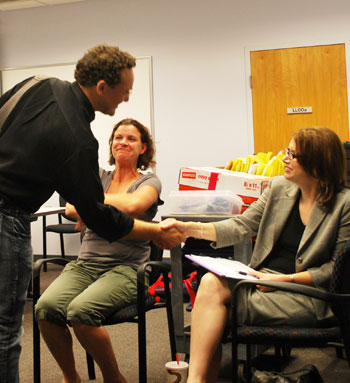
Conan Smith, Washtenaw County commissioner for District 10, greets city of Ann Arbor clerk Jackie Beaudry. Seated next to Beaudry is Lyn Badalamenti with the city clerk's office.

Dave DeVarti (left), former city councilmember and former Downtown Development Authority board member, was one of Yousef Rabhi's official watchers. Rabhi is standing on the right.





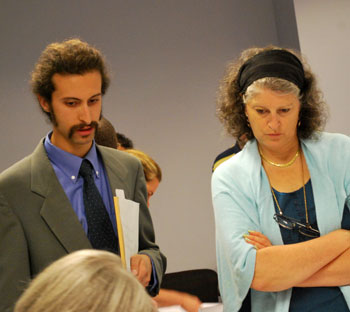
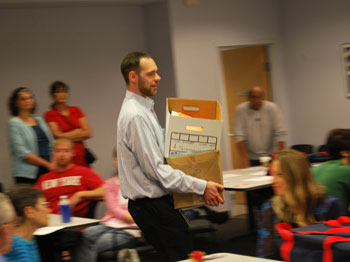
I’m happy that Yousef won, but why does Conan Smith always appear so smug?
@1: In my experience, when someone appears a certain way to me it’s often because of what I’m projecting onto them.
I notice, Dave, that you didn’t go for the “Fried-Rabhi Recount” alternative headline. I’m surprised you passed up that (slightly misspelled) play on words.
What is ironic is that Conan Smith’s grandfather, Al Wheeler, had been involved in one of the closest and most protracted and disputed elections in state history that wound its way through the court system.
That was the race for the City of Ann Arbor mayor in the 1970s and a very fine gentleman by the name of Mr. Stephenson, nominated by the Republican Party, eventually prevailed and assumed office as Mayor.
Correction: That should have been Republican Louis Belcher, not James Stephenson, who had been the outgoing mayor that Wheeler had replaced prior to the Belcher election run.
It also should be noted that the Belcher-Wheeler race had been decided by one vote prior to any recount and a later “special election” that Wheeler lost eventually gave Belcher the mayor’s office.
I’ve met and spoken to Mr Smith a dozen or more times and he often comes across as falsely humble, obsequious and oh so gently patronizing and condescending.
Mr Bean might do better by limiting the use of his own psychoanalytic skills on his potential voters.
“That was the race for the City of Ann Arbor mayor in the 1970s and a very fine gentleman by the name of Mr. Stephenson, nominated by the Republican Party, eventually prevailed and assumed office as Mayor.”
Back in the days when I had a “Ann Arbor: Dope Capital Of The Midwest–James Stepenson Mayor”…t-shirt with a picture of Stephenson from the Human Rights Party.
Which probably should be updated for 2010 to “Ann Arbor: Home of the Giant Urinal Art Fountain Fiasco–John Hieftje Mayor” with a pic of the giant…oh never mind.
Mr. Dairy, I’m sorry you have such a sorry impression of me. Drop me a line at smithco@ewashtenaw.org and let’s have a cup of coffee.
I really enjoyed being a part of this process. It was great to see how civilly and professionally the elections officials and the candidates’ teams handled themselves. It’s a tribute to both Mike and Yousef — and frankly wholly reflective of their very positive and honorable campaigns — that this recount wasn’t marred by even the most minor slight. I think these guys showed our whole community how politics and campaigns should be managed.
One correction, prior to the canvassing of this election and this recount I officially refused to take payment for my duties as the chair of the county board of canvassers. You can subtract $25 from the cost of the recount.
As a former election integrity activist, it is my opinion that our election system is seriously flawed with no opportunity for citizen’s to monitor their own precinct, in a manner that really counts, and where it really counts. We have a system just waiting for a crook.
In light of my last statement, I am honored to say that the folks in Washtenaw county have given me no reason to believe that crook exists here. From the election inspectors to the local clerks, to the county clerk, I have been very impressed with their integrity and professionalism. My hats off to them.